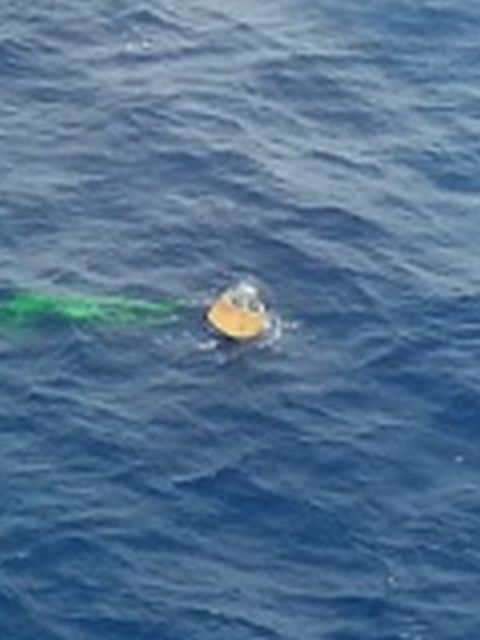---
http://isro.org/gslv-mkiii-x/Imagegalle ... ii-x16.jpg
the high res.. some one can read those marking on those two white floats?
http://www.globalsecurity.org/space/wor ... iloted.htm
for comparisons


Was supposed to be around than 5 meters/secondSaiK wrote:any data on the landing speed at touch down? wondering about the parameters for touch down on land rather sea surface.
yes indeed - that was how SRE1 had landed - inverted with flotation device upwards.Apollo etc landed vertically with flotation ring below which is what the crew module will ultimately have to do.Shalav wrote:Not wise to put flotation devices positioned so that the rest of the capsule is submerged including the crew hatch. That portion is the top of the capsule in normal orientation. It makes more sense to position the flotation device at the widest part of the bottom of the capsule around the boundary between the brown and black tiles.
Yes. I agree that it was launched upside down but even then deployment of a flotation device which si a terminal event would not be compromised because it was launched upside down. Yes the flotation ring would have to be between the black ablative shield and the brown ceramic tiles.Probably they were only interested in testing reentry issues as they had already tested the flotation device technology in SRE1Shalav wrote:Prasanna,
The capsule was not in the correct orientation for this TD . It was launched "upside down". The next test flights will have them in the correct orientation. Hence flotation devices, if added, will be at the boundary of the black and brown tiles.
They have to use retrorockets as they don't have water to cushion the landing. It is an interesting thing - some of the retrorocket firing photos of Soyuz look like a fireball!Shalav wrote:Landing velocity was reduced from the orbital 5km sec to around 2m/sec IIRC from the video.
On land touch downs the Soyuz capsule uses retro rockets
http://www.flickr.com/photos/nasahqphoto/4669580709/
Remember that LVM3 accelerated the capsule to 5 something km/s and descended from ~125 kms. An actually capsule orbiting the earth will have a much higher velocity than this and will returning from a much higher altitude building speed in this process. So, the conditions will be even worse in case of re-entry from a low-earth orbit.prasannasimha wrote:The tiles look really good and do not look scorched like we see the Soyuz/Apollo and Shenzou reentry capsules. I cannot see the buoys/flotation devices.Wonder how it is floating.
No in G suits ffighter pilots are exposed to sometimes 9GSaiK wrote:>5g, I'd expect it is not safe even with a ji-hosoor-suit.


hmmm...prasannasimha wrote:
India's biggest rocket, the LV M3 blasted off from Sriharikota precisely at 9:30 am this morning, a mission that enables the Indian Space Research Organisation to continue to plan big.
Today's launch of a new powerful rocket system means India can plan serious deep space missions in the future. Today's success comes a few months after ISRO surprised the international space community by placing a satellite into Mars orbit in its very first attempt, something not achieved by any other nation.
ISRO now has its sights firmly on a manned Indian space mission and the LV M3 today carried the prototype of India's unmanned crew module, which could ultimately carry 3 Indian astronauts to space if the government clears a 12,500 crore budget for a manned mission.
On Twitter, Prime Minister Narendra Modi hailed the test mission as "yet another triumph of (the) brilliance and hard work of our scientists" and the Chairman of ISRO, Dr K Radhakrishnan said, "This was a very significant day in the history of (the) Indian space programme" as his fellow scientists and engineers cheered on at the Mission Control Centre at Sriharikota.
Today's mission lasted approximately 20 minutes and culminated in the successful splashdown of the crew module into the Bay of Bengal. Not only had the crew module separated successfully from the LV M3 rocket, its heat shield withstood the high temperatures of atmospheric reentry, its parachutes deployed correctly and in sequence, and its speed was successfully retarded as it made a successful splashdown in the Bay of Bengal off the Andaman and Nicobar islands.
It will still take another two years for the LV M3 rocket to be fully operational. One of the motors being carried onboard the rocket today was in fact a dummy of India's largest ever cryogenic engine, which is still being developed and will need to be flight tested in future missions. In the immediate run, the new rocket, weighing 630 tonnes and capable of carrying 4 tonnes, is a boost for India's attempts to grab a greater slice of the $300-billion global space market.
With today's successful mission, India has a brand new heavy launch rocket and a working crew module. Though many more tests are required, today's mission has meant that an Indian manned mission to deep space may not have to remain a dream.

parachute , maybe ?prasannasimha wrote:
You can see the green color in the water- Is that a dye released to aid detection of the module apart from the radio beacon.
IIRC, yes.You can see the green color in the water- Is that a dye released to aid detection of the module apart from the radio beacon.
From the plot they showed on TV, until almost the end of the L110 shutoff, the rocket performance was slightly deviating from the projected ones. Was that the underperformance ? I don't know. But just before the L110 shutoff, the actual and expected lines merged. Not sure what was going on.SSridhar wrote:It would be interesting to know how closely to the predictions the two S-200 boosters performed.
There was a minor divergence in the projected plot vs actual plot when the S200s were active..SSridhar wrote:It would be interesting to know how closely to the predictions the two S-200 boosters performed.